
How to Write Powerful Product Descriptions that Sell
Well-crafted product descriptions can significantly improve your conversion rate. Here's a step-by-step process for improving yours today.
Here’s something we’ve learned from over a decade running A/B tests on hundreds of Product Detail Pages: Optimizing your product descriptions is one of the highest-return, lowest-investment improvements an ecommerce manager can make.
Why?
They’re a key part of your potential customer’s decision-making process; 87% of consumers rate product content extremely or very important when deciding to buy.
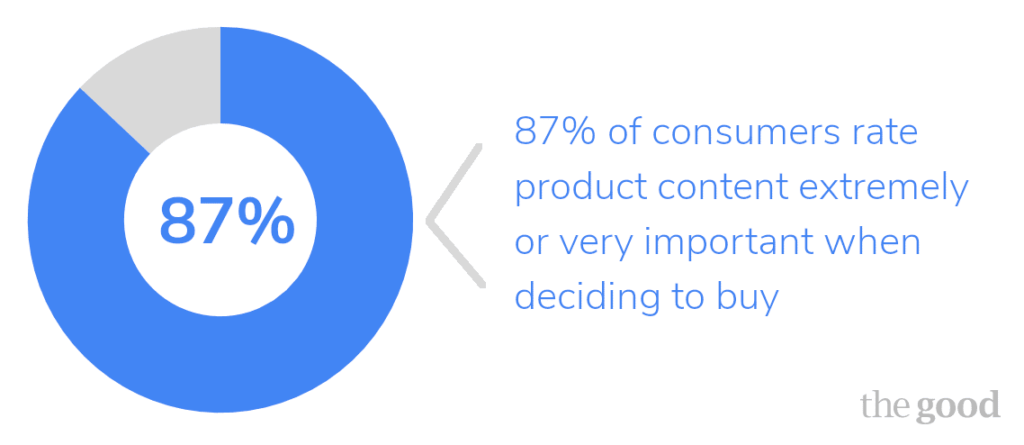
Meaning, if you’re not optimizing your product descriptions, you’re certainly leaving money on the table.
And while optimizing your product descriptions means, yes, you’ll be working with words, you don’t have to be a pro copywriter (or marketer) to win that money back. Effective product descriptions are more about defining who you’re talking to and why they should care than crafting the perfect pithy pitch. Chances are, that’s work you’ve already started!
Even more good news — you don’t have to do anything near as complicated as double-down on pay-per-click, rebuild your Shopify website, or block out a week’s worth of your team’s time. With a little bit of effort and a few handy steps, you can craft (or quickly optimize your existing) product descriptions into a full-time, friendly salesperson — the kind that makes your ideal prospect and returning customers go, “wow, yeah, I think I need this.”
In this article, we’ll walk you through a step-by-step approach you can use to create or overhaul your current product descriptions…and improve revenue and conversion rates, too.
Here’s what’s ahead:
- The real job of a product description
- An effective product description template
- Steps to writing a product description that converts
- Product description FAQ
P.S. Already put a ton of time into developing your current product descriptions? Don’t worry. You don’t have to start over from scratch. A solid editing pass (see Step 6) may be just the thing you need to amp up the value of what you have.
What does an ecommerce product description really do?
First off, let’s poke a hole in the idea that the job of an ecommerce product description is to describe the product. Given the name, it makes sense most folks think this. But your product descriptions aren’t just there to describe what’s on your Shopify or ecommerce site, they’re also there to:
- Qualify: They help website visitors quickly assess “is this for someone like me?”
- Persuade: They provide compelling, customer-centered reasons to consider the product.
- Surface: They use SEO keywords and search terms in a natural way, so the page shows up in search engine or Amazon results.
Here’s one to think about it: product descriptions are a bit like 24/7 in-store retail associates for your online store. And just like live retail associates, they can help or hurt conversions for potential buyers. On the one hand, I’ve had encounters with store associates at Verizon that have — no exaggeration — brought me to my wit’s end, made me want to toss my beloved iPhone in the trash, and move somewhere without cell service. Yikes. But on the other hand, I’ve also had interactions at Athleta, coffee shops, and other retailers that make me feel like I’ve “come home” and the products were made just for me. I made happy purchases and returned often for more.
Your product descriptions, as your virtual retail associates, can have a similar impact. If they do their job well, they’ll draw visitors to your goods and increase conversions. If they do their job poorly, they’ll frustrate visitors, push them away, and hurt sales.
No time to read?
Get the highlights in 12 minutes.
What are some good product description examples?
There are two extremes a product description land on. One generates sales, the other doesn’t. Since it’s helpful to know where you want to go, as well as where you don’t want to end up, let’s look at both.
Losses: Bland and nondescript examples
Let’s start with where you don’t want to end up — the island of product description blah and meh.
Descriptions that live in this category make one or more of the following mistakes. They:
- Don’t exist (really, we see this more than you’d think!)
- Screenshot or verbatim copy the manufacturer’s description
- Copy/paste from a print catalog
- Give too much attention to technical details in the product copy
- Rely too heavily on product images or product photos to tell the whole story
- Use self-centered language (they’re brand-focused instead of customer-focused)
- Hurt readability (e.g. small and/or light-colored text)
Those are all a sure path to being ignored by prospects and search engines alike.
For example, here’s a brand I’m a target buyer for but recently ignored. As a momma-to-be, I am actively purchasing maternity clothes. But Hatch has a long way to if they want to convince me to splurge on a pair of their jeans. While their product description is packed full of product features, I only spied one clear benefit (I can, uh, tuck my t-shirt in?).
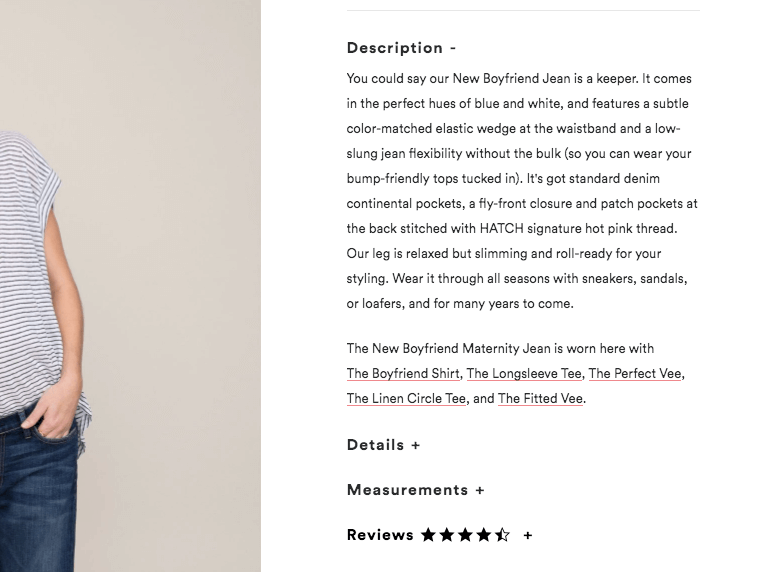
I’m left to wonder why this pair of flexible denim commands an eye-popping $260 price tag for the 4 months I’d wear them.
Another “meh” example comes from a tech-accessory company, Nomad. Their docking station looks super sleek, and it apparently does something for my devices. But even after working in and around tech for over 6 years, I’ve no idea what their self-serving and jargon-packed description means.
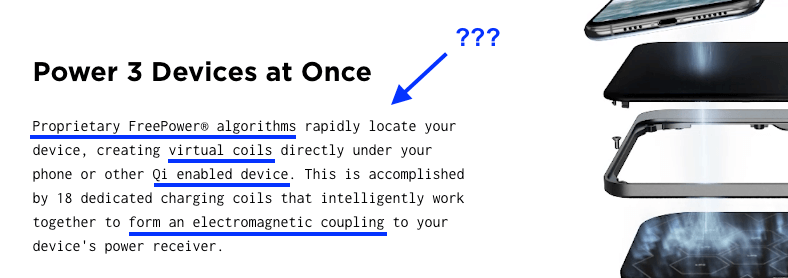
So, those are places you don’t want to end up. Let’s look at some better examples.
Wins: Informative and persuasive examples
The other place your product descriptions can land is on the island of product description I need this ASAP. This is where product descriptions do their job (to qualify, persuade, and surface), very well.
For example, I own an occasionally anxious dog, and this description from Finn instantly intrigued me. The copy quickly qualified what the product is and who it’s for (dog owners with stressed out pups), plus it persuaded me that it was useful with plenty of me-centered benefits (it relaxes my pup AND keeps them healthy — a win-win!).
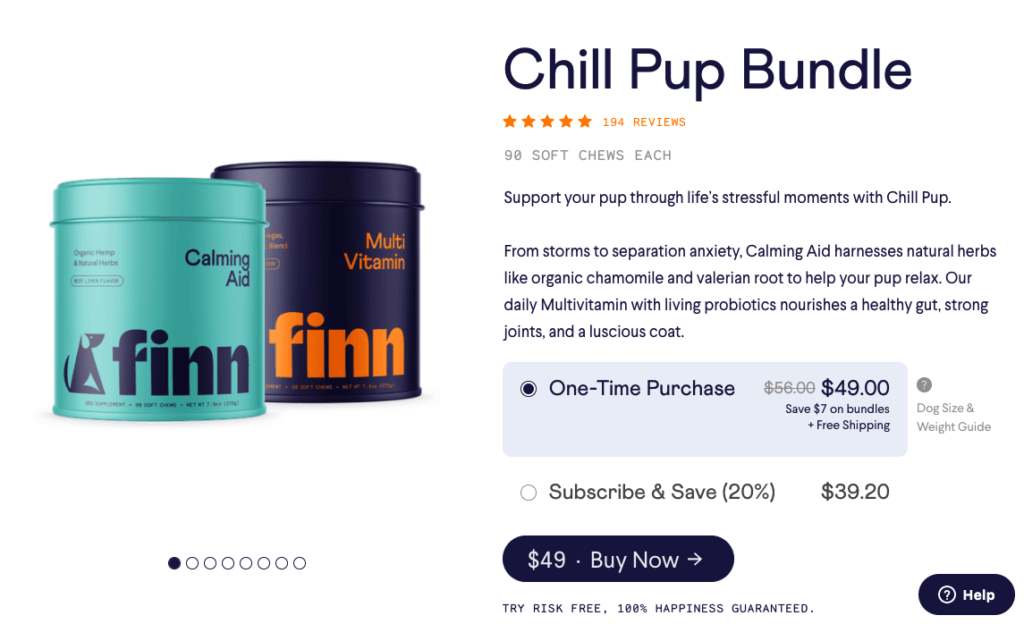
However, keep in mind “greatness” comes in all shapes, sizes, and, er, tones. Take the much wackier and informal themed descriptions over at Barkbox (the one below is for a snow day).
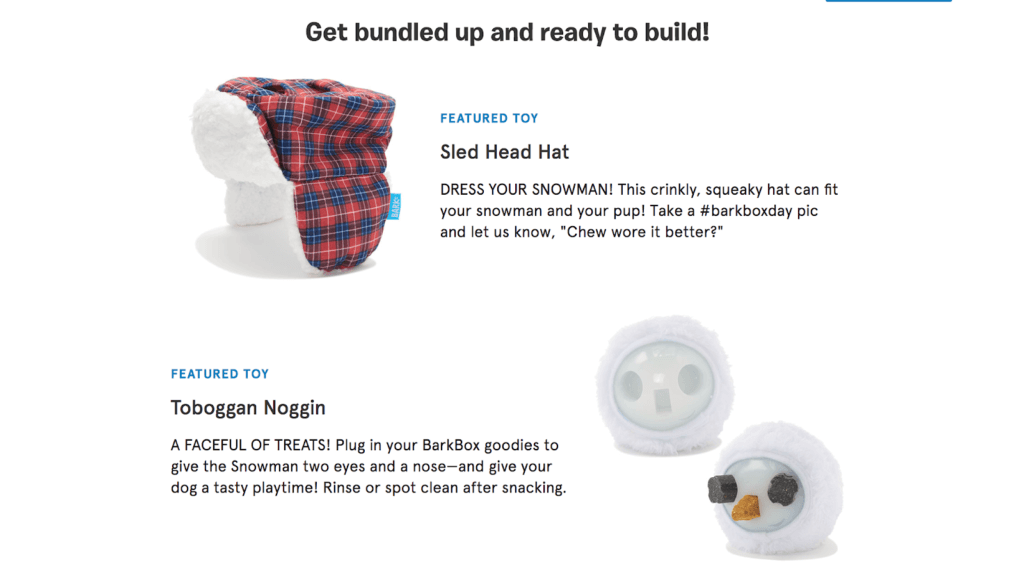
These two pet brands look and sound very different, but they both do a good job — and for all the same reasons. It’s important to remember what “excellent” looks like will vary according to the target audience, brand, and product (more on that below).
To craft a winning product description that works for you, use the template below as a rough outline. Then, follow the steps beneath the template to color in a description that’s specific to your unique customers, brand, and product.
A simple ecommerce product description template and how to use it
The template below is your starting point for your product descriptions. Keep in mind, it’s an intentionally flexible starting point. Think of it less as a blueprint and more of a guideline you’ll customize using the steps that follow.
- Descriptive headline: Use a product title that will hook your audience. Bonus points if you connect with them emotionally.
- Benefits-focused paragraph: Use a descriptive paragraph to explain why, exactly, the consumer benefits from the product.
- Key benefits list: Follow the description with a bulleted list of key product details and features.
- Additional motivation: Minimize any remaining purchase hurdles (“will it fit?”; “do others like it?”) with credibility, social proof, product reviews, or urgency, and/or a call to action.
Here’s a pretty minimal example of how this can look, via Outdoor Voices.
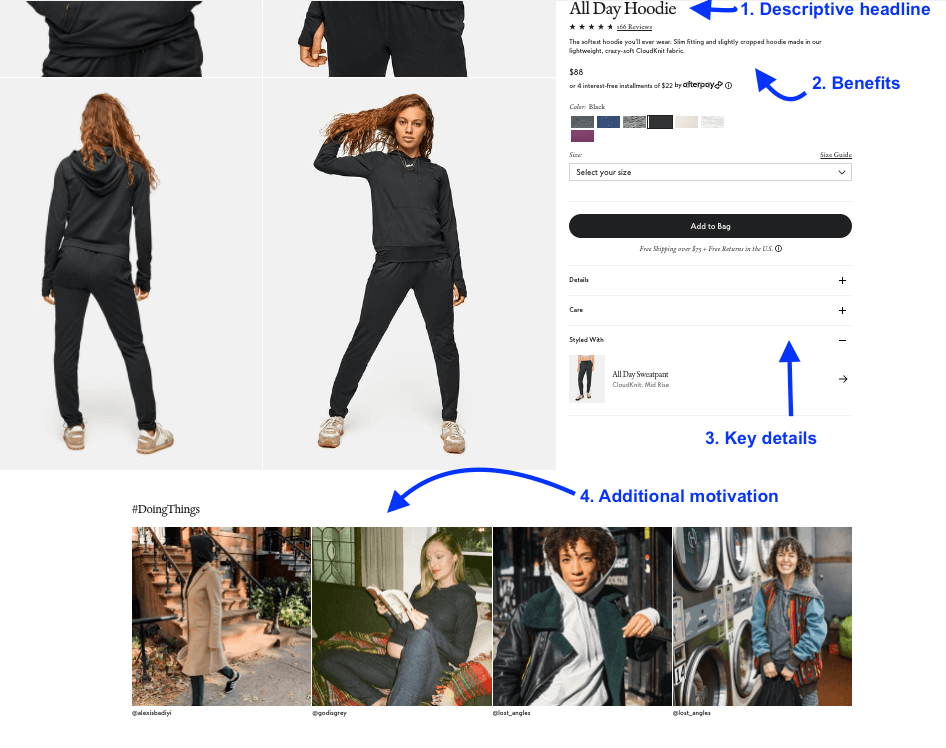
How to Write and Optimize Product Descriptions That Convert (with examples)
Alright, you have your rough outline, now what? You’re going to use information about your customers, brand, and product to fill it in. Here are the steps you’ll take to do that:
- Know who you’re speaking to and what their pain points are
- Define and refine the voice you speak in
- Focus on solutions more than features
- Keep if effective and efficient
- Write as if they’re right in front of you
- Run through a final edit checklist
By the end, you’ll have a product description that’s engineered to convert potential buyers — though, of course, we’d advocate for testing it!
Let’s look at each step in detail, with plenty of examples from the ecommerce wild.
Everything You Need To Know About Building A Product Page That Converts
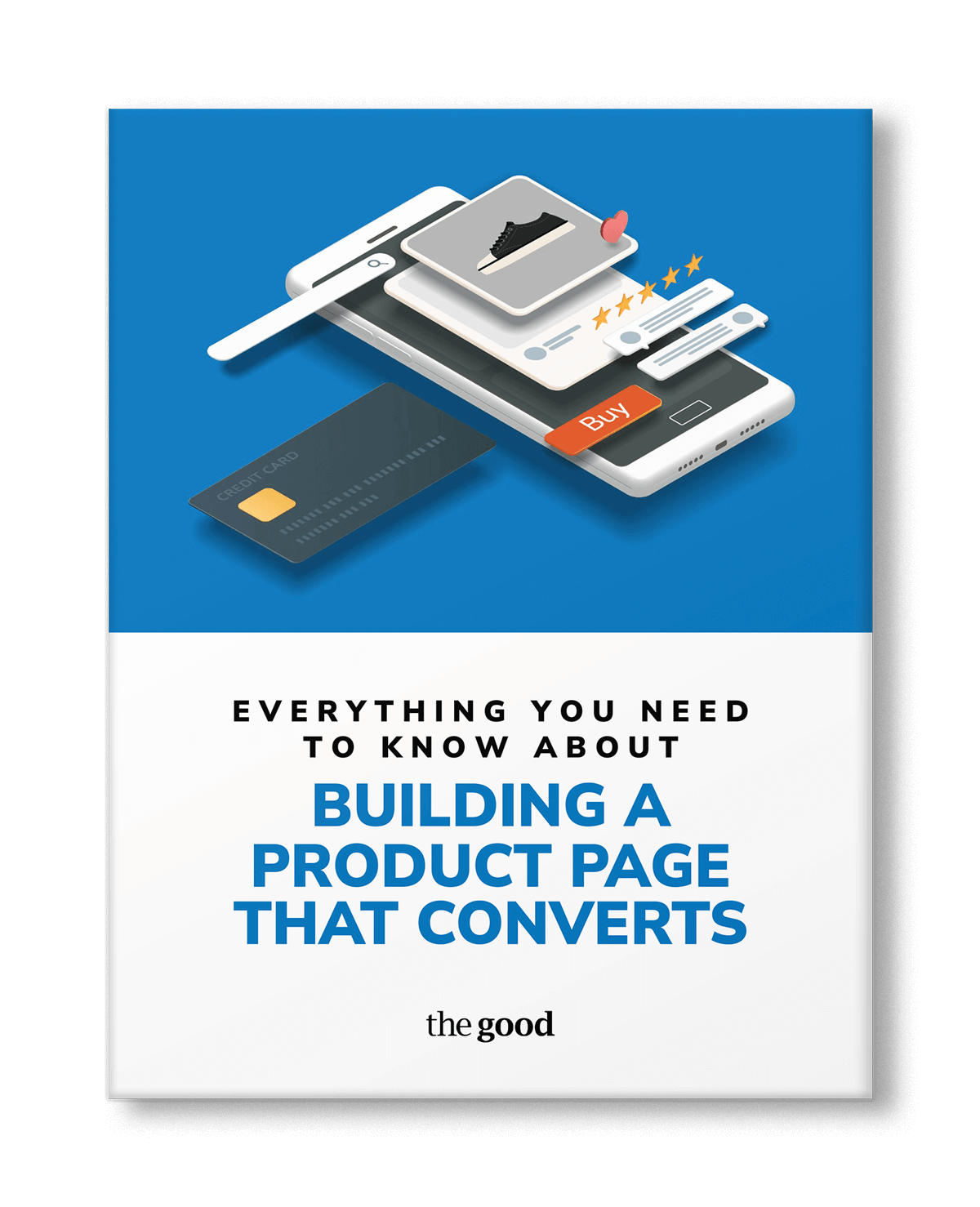
Step 1: Figure out who you’re speaking to (aka your ideal prospect)
You’ve likely heard the adage “everyone is not your ideal customer.” That’s important to keep in mind for your product description. If you try to sell everyone, you’ll end up selling to no one.
To avoid this mistake, speak directly to your ideal customer, and don’t worry about the rest. To do this, your first job is to know who your ideal customer/prospect is, what difficulties that prospect faces, and how your product will help the prospect overcome those difficulties.
If you haven’t defined your ideal prospect before, begin by asking these questions:
- Who could most benefit from this product?
- What problems will this product solve — or what pain points does it address — for those prospects?
- What desires will owning this product fill?
- What objections will the primary prospects have during their purchase decision?
- Why should they buy from me instead of a competitor?
- What words or phrases do they use to talk about the product?
These questions will help you create your rough buyer personas. Your personas should be front and center when writing the copy for the product descriptions. As in, tape them on your computer screen next to your word file when you write your descriptions!
For example, here’s how you might answer those questions above for a natural deodorant product:
- Who’s the potential customer? Men and women who are fed up with chemical-packed deodorants
- What problems does it solve? Keeping them stink-free for more than 5 minutes
- What desires does it fulfill? Feeling healthier and more responsible (toward their bodies and the planet); feeling less dirty and smelly
- Objections? Other natural deodorants just don’t seem to work or lie about the ingredients
- Why you? Compared to those other guys, this deodorant actually works
- What words do they use? “Natural” “fresh” “scent” “confident”
Understanding all this lets you craft a compelling description like Schmidt’s deodorant does:
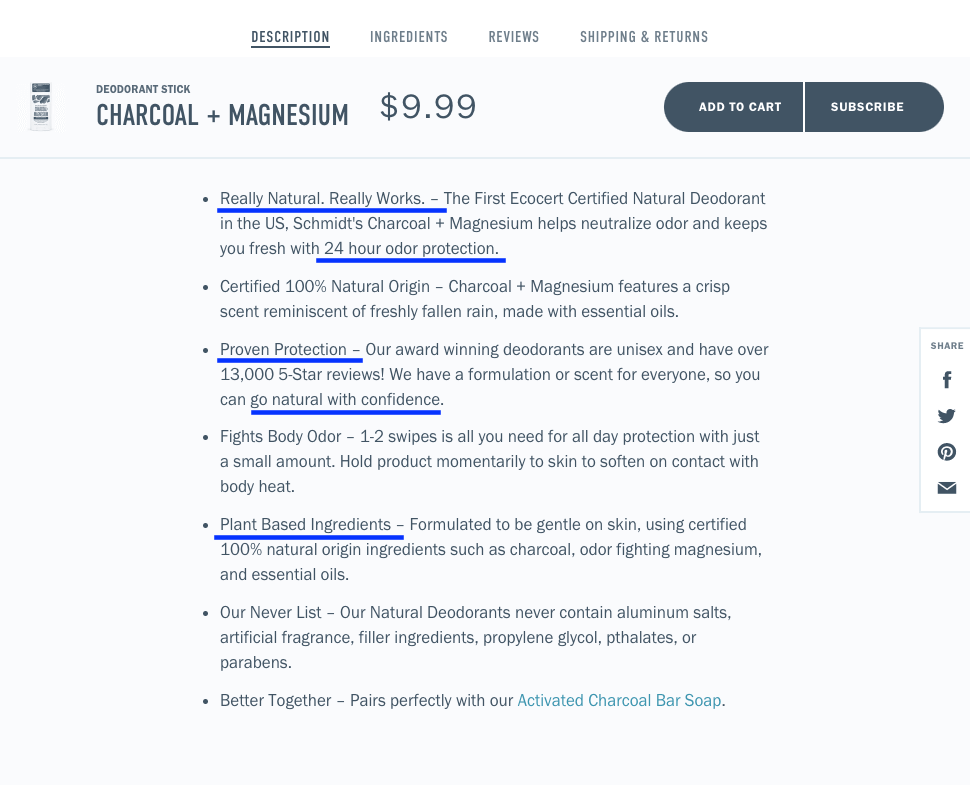
One last prospect tip: remember to choose a target persona for each product description on your ecommerce site. Your different products are going to cater to different buyers. So, identify who can benefit from the particular product you’re working on, then speak to that unique person in your description (that’s the next step).
Step 2: Define and refine the voice you use to speak with your prospects
Once you’ve nailed down WHO you’re speaking to, your next step is figuring out HOW to speak to them. Are you talking to them like you’re both in a boardroom? Or like you just met up for beers with the dogs?
Just like there are a variety of ways a retail associate can talk with you in a store (for better or worse), there are many different ways a product description can talk with your visitor. What you want to figure out is which “voice and tone” is most persuasive for your ideal prospect.
Mailchimp defines voice and tone this way: “You have the same voice all the time, but your tone changes. You might use one tone when you’re out to dinner with your closest friends, and a different tone when you’re in a meeting with your boss. Your tone also changes depending on the emotional state of the person you’re addressing. You wouldn’t want to use the same tone of voice with someone who’s scared or upset as you would with someone who’s laughing.”
Your voice and tone could be edgy and humorous, like Cards Against Humanity.
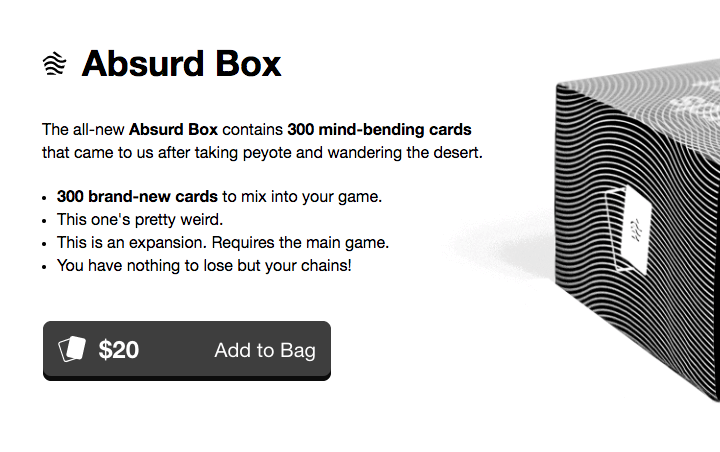
Or more reserved and refined, like Felix Gray.
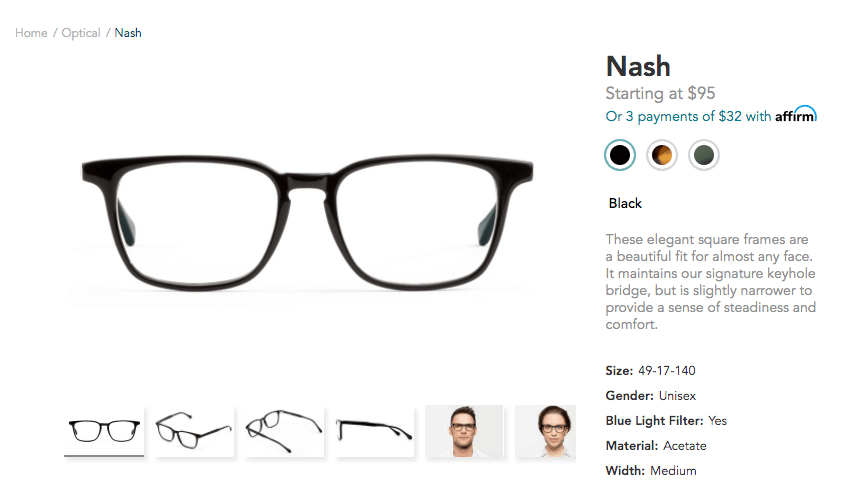
Or warm and friendly, like the BFF you call when you need a pick-me-up. That’s Jeni’s ice cream.
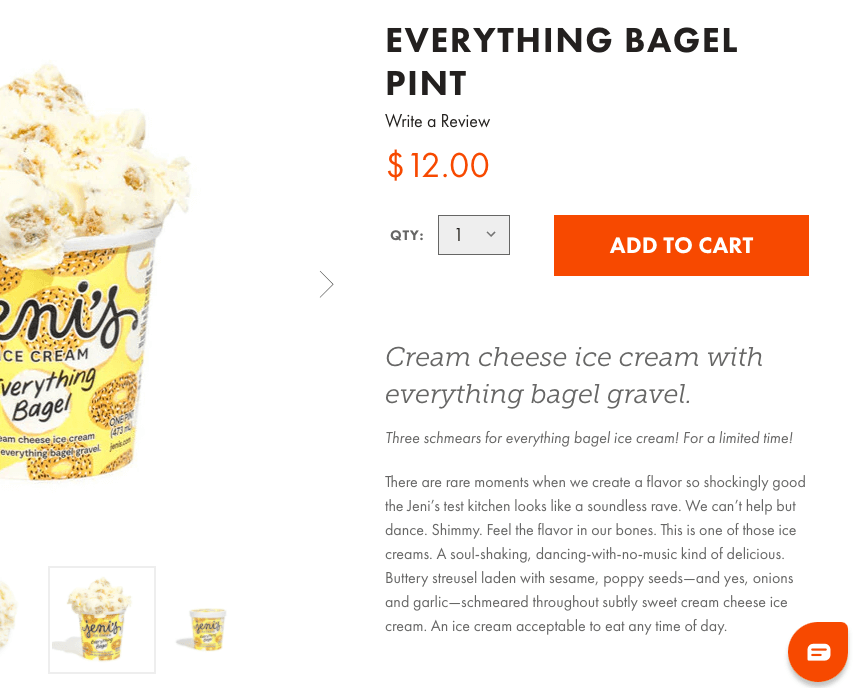
And this is only a sampling. There are nearly as many voice and tone options as there are brands. What’s “right” for your product descriptions will depend on two key factors:
- Your ideal prospect: What’s their emotional state when searching for/needing this product? What kind of language do they use to describe or search for it?
- Your brand: What impression are you trying to make and how do you want to come across?
Balance how your prospect speaks with how your brand speaks
Even though each product may have its own targeted prospects, you don’t want to radically shift your voice and tone between products. It’s important to stay in tune with your brand voice and brand image in every product description. Getting out of tune might not be a big deal in a one-off email 20% of your subscribers read once, but your product descriptions are different — they’re being viewed constantly.
Here are some questions that can help you intersect ideal prospect and brand, to nail down the voice and tone of your description:
- What are customers thinking and feeling when they find this product?
- What kind of tone and language do they use in reviews, searches, or conversations with peers about this kind of product?
- What tone would a high-performing salesperson adopt with your best prospects for this product?
- What is your company persona? (Is your brand relaxed and humorous, or is it premium and serious? Or something else?)
- What separates you from the competition?
- What company values should be obvious in anything you write?
Questions like these help you — and anyone else writing product descriptions — stay true to the mindset and voice of the company. Remember, keeping your language aligned with your brand helps build and maintain trust.
Two other voice and tone tips:
- Nostalgia is powerful. Explore how you can include positive memories in your descriptions.
- Likewise, humor can ease the stress of buying – as long as it fits your brand. Give your prospects a good laugh to help create a positive, lasting impression.
Step 3: Focus on solutions more than specifications
Kathy Sierra, an American programmer and game developer, once said, “The secret to building great products is not creating awesome features, it’s to make your users awesome.” And in her 2015 book, Badass: Making Users Awesome, she argues, “Most companies compete on the quality of the product, not the quality of the user’s results with the product. Competing on user awesome means fewer direct competitors, even within the same product/service category.”
She was talking about software, but the key lesson here is just as applicable to ecommerce:
Your target audience is less interested in your product than what they can achieve with your product. They’re interested in how buying your thing makes them more awesome.
This is something you can help them see in your product descriptions. And an easy way to do that is to frame product features and relevant information as must-buy benefits.
For example:
- Encourage prospects by applauding their aspirations
- Help prospects visualize what they can achieve with your product
- Help prospects imagine the product is already in their possession
- Use sensory language to explain how the customer will feel using the product by; tap into the five senses (sight, sound, taste, touch, smell)
- Help them imagine how their current needs are being met by using the product
- Highlight the problem before you sell the solution
- If you want to sell big mousetraps, turn the mice into rats (magnify the problem)
Take Welly. For their bandaid kits, they do an excellent job highlighting the problem (tricky hand wounds) and how their product solves related needs (extra-long bandages that don’t slip off) to persuade the visitor.
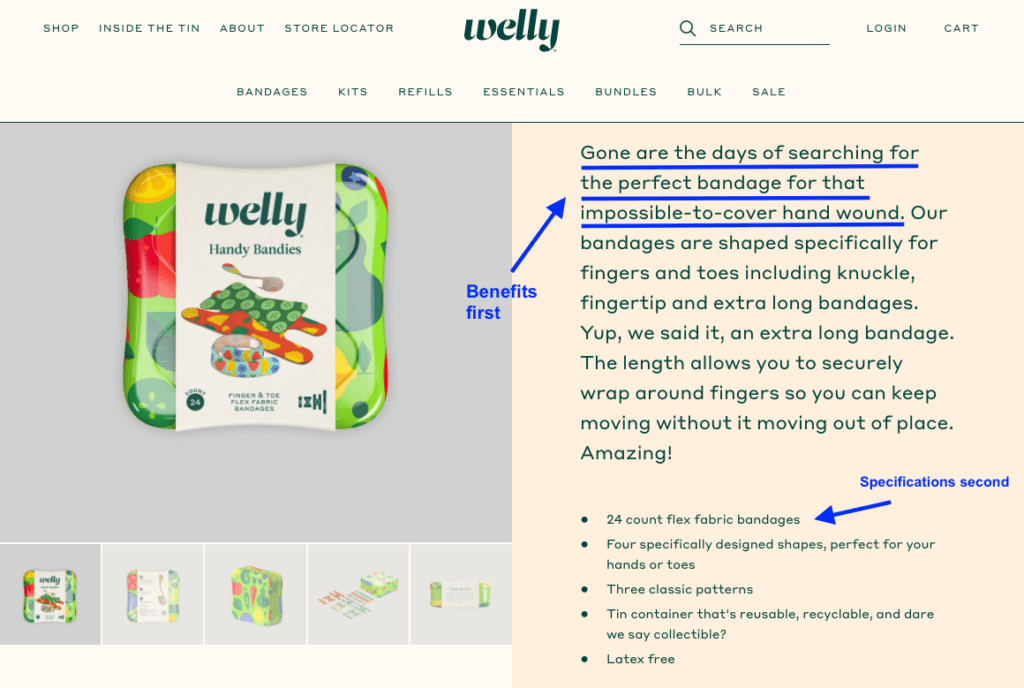
Also note that instead of leading with a feature like “a tin of 24 flexible bandages”, they focus on why this bandage tin is the solution you’ve needed for that frustration you feel when a bandage falls off your finger (again): “Gone are the days of searching for the perfect bandage for that impossible-to-cover hand wound.”
Does this mean you throw feature lists in the trash?
Does focusing on benefits mean the new rule of thumb is “no specs lists”?
Not quite. Specs are important decision criteria for many products. Take buying a water filter. When my husband and I traveled to New Zealand, we decided to purchase a water filter because we planned to camp beside many lakes and streams. If we had a filter, I wouldn’t have to worry about finding side-of-the-road stops to refill water bottles. When I shopped for a filter, some of the things I cared about included: exact weight, volume of water the filter could handle, and what size molecule could pass through the filter. I needed those specs to choose the right option.
Including specs is less of a “yes/no” question and more of a “where are they most effective?” question. The answer is this: as supporting material.
Great product descriptions lead with tangible consumer benefits that illuminate and solve consumer problems first before diving into features. For example, REI does a good job leading with the benefits (though they label them features) of the top-of-line MSR water filter. The nerdy technical details come after:
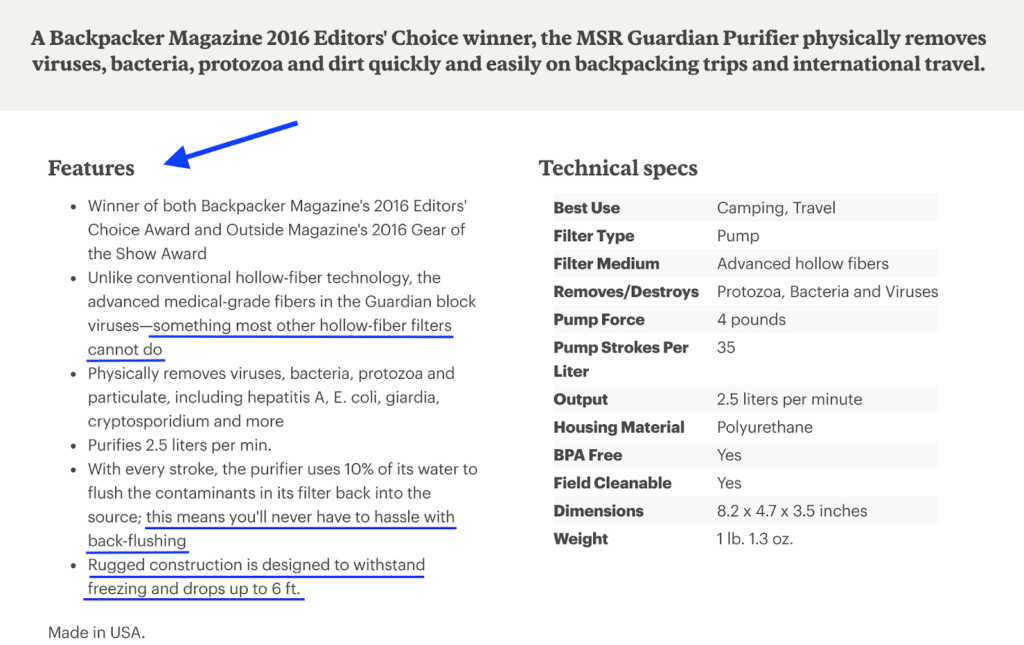
This is effective. REI first sells me on this product’s ability to eliminate virtually all my water concerns (It filters stuff other filters can’t! I can drop it off a small cliff and it won’t break!) before listing the technical reasons those things are true.
Step 4: Structure your descriptions so they’re scannable, effective, and efficient
Once you’ve figured out what benefits to lead with, you want to balance saying too much with too little.
On the one hand, you can deliver a firehose of information that is useful piecemeal but overwhelming as a whole. This “wall of text” approach can paralyze a visitor. On the other hand, you can include too few details or information to be useful. (Remember, this is one of the common mistakes many descriptions make.)
Beam, for example, has a great-looking product with a load of good reviews. But there’s so little compelling information in the product description that I’m left confused (It’s…hot chocolate? But with CBD?) and hanging.
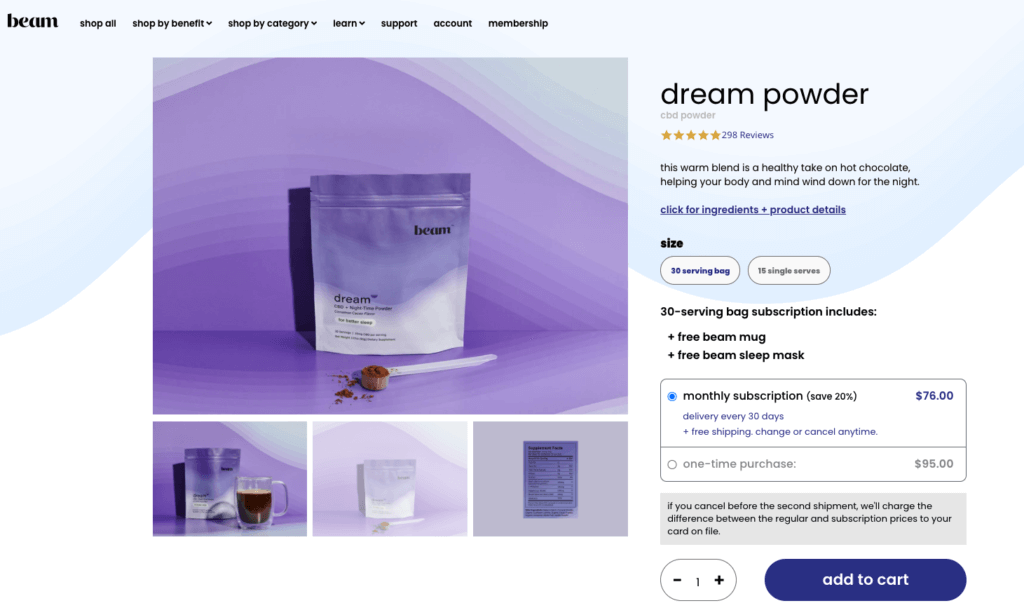
Aim for plenty a paragraph of useful benefits that’s scannable as well. Overall, you want to structure your product descriptions so visitors can scan them quickly. Bullet points, short paragraphs, and relevant headings are all ways to help with readability and make your description easier to digest.
You can also follow a template. For example, try this format for your next description:
- Introduce the product
- Set up the problem
- Describe the solution in a persuasive way
- End with a call to action (move the prospect closer to becoming a customer)
Caraway leverages this approach well with their cookware set:
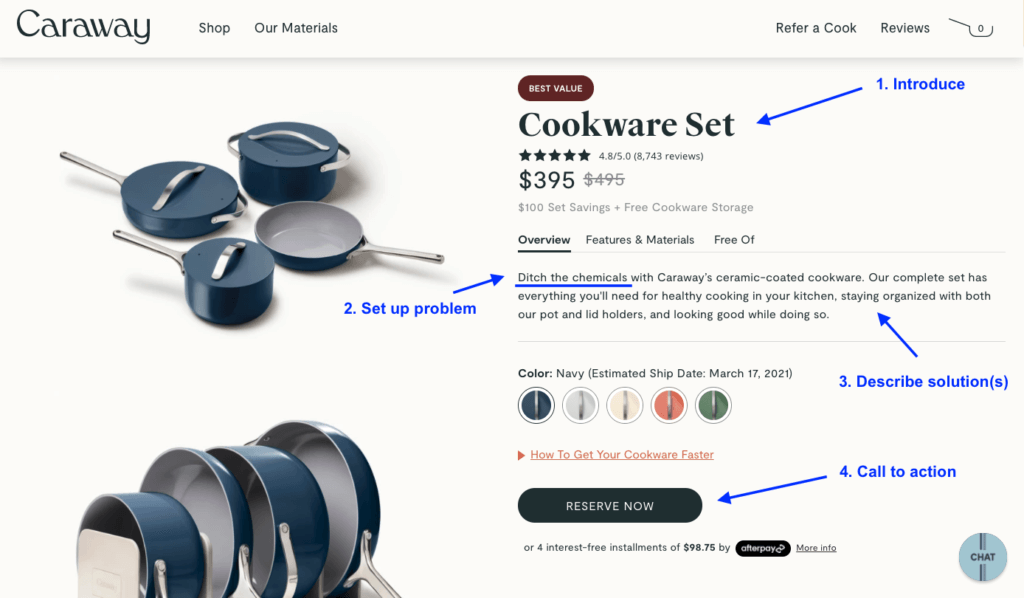
Another great way to say more with less? Videos
Another way to simplify your product description without losing value? Use product page videos. A study conducted by LiveClicker surveyed ecommerce business owners and found 88% saw conversions increase when they implemented product page videos.
Think of it this way: A product image says a thousand words and a video says tens of thousands.
Take Atoms. They have a great product detail page that highlights the benefits of their shoes, while also offering plenty of imagery and a product video to give customers a full picture of the product.

Icons and graphics can also help buyers skim
Icons and graphics are another way to make your product descriptions more skimmable, without cutting back on key info.
Goodr, a humorous and sporty sunglasses brand, does a particularly good job with this. Click on any pair of sunglasses and you’ll see icons that immediately help you figure out: Is this the right pair for what I do? Will it fit my head? What else are they good for?
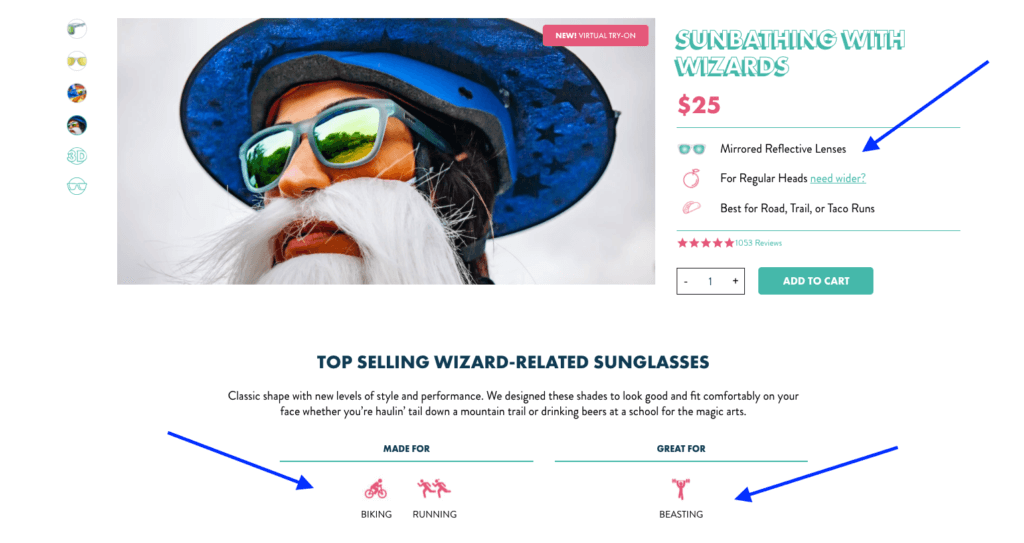
Hydrant, a DTC brand distributing powdered electrolytes, found a similar way to efficiently describe their products. Instead of waxing on about how sweet or tart a specific mix is, they simply show you on a no-brainer scale:

Step 5: Write as if your buyer is right there with you
Some of the best copywriters have a trick for writing persuasive copy, and it’s one you can use, too:
Write directly to ONE person.
For you, this means writing like you were selling and describing the product to the ideal prospect you identified back in step 1. Picture they’re standing right there in front of you. Focus on being persuasive and energetic. Use the second person “you” to address your target customer directly, the way Great Jones does in the example below.
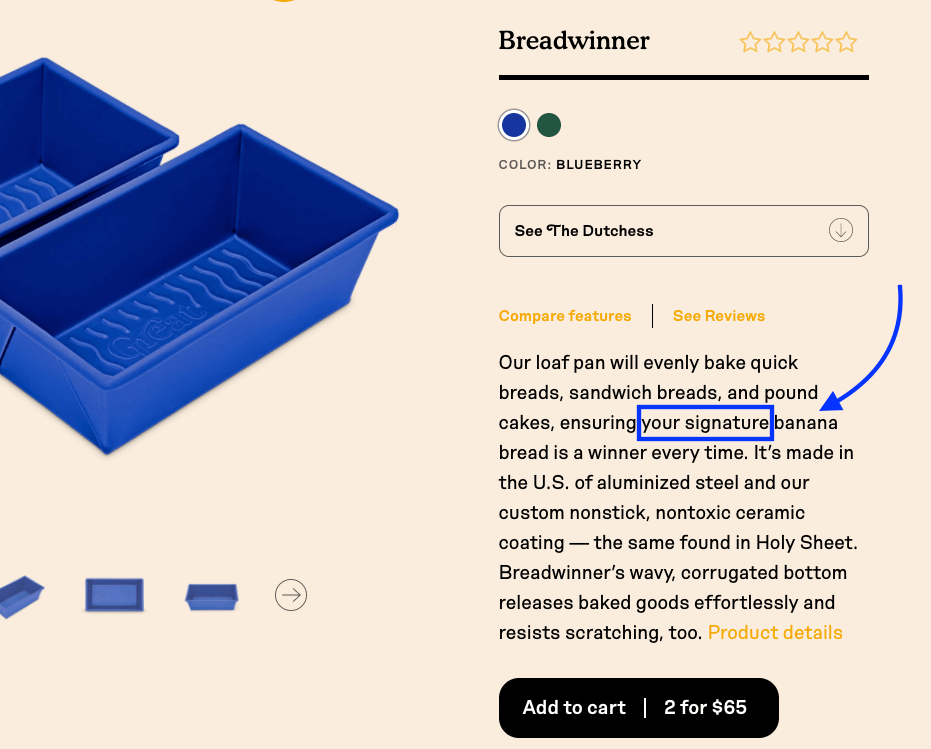
If you’re finding the “be persuasive” piece tricky, here are a few extra tips for writing product descriptions that persuade and convert:
- Keep sentences short and to the point
- Make an emotional connection with your audience
- Highlight what the prospect will feel after using your product
- Empathize with the challenges your prospects face
- Agree with their pain and emphasize how your product relieves it
- Sell a lifestyle that will keep them coming back
For example, the Youth to the People descriptions below is a bit wordy (it could improve there) but where it shines is highlighting how the visitor will feel about using it (brightened, refreshed) and the lifestyle that will keep them coming back (skin that looks amazing).
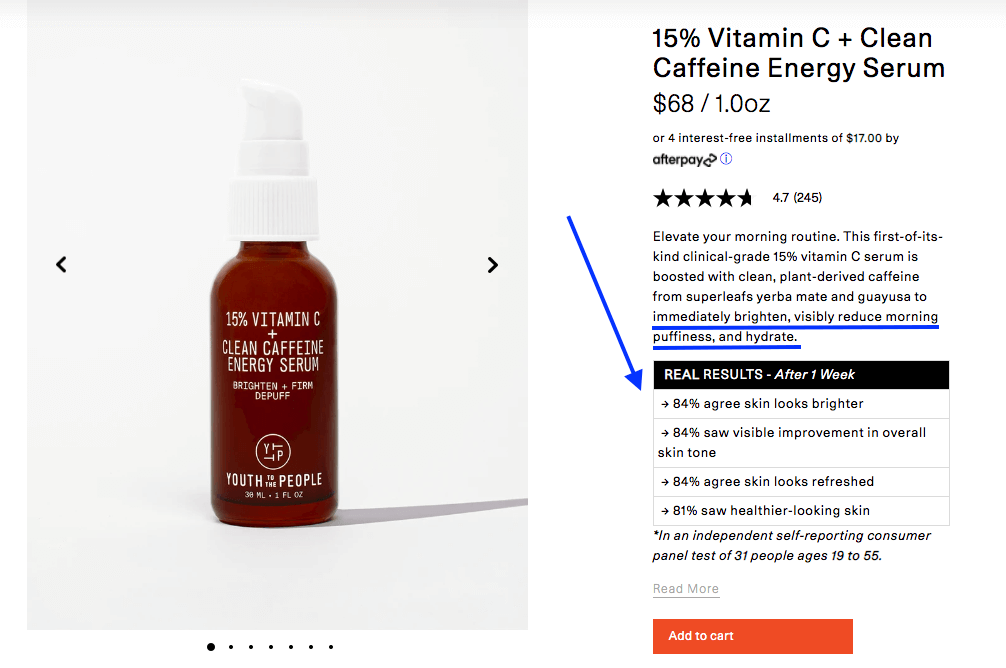
A great gut-check: read your product description out loud
A good way to test how your description is coming along is to read it aloud. Ask yourself if it sounds like a real conversation you’d have with your target audience.
If you find yourself getting tripped up on certain words or phrases when you do this, like a briar is catching your sleeve, pay attention to that. It’s a sign a piece of copy doesn’t sound or feel natural. Keep tweaking and reading it out loud until you don’t stumble.
Also ask:
- Does it flow without dragging out into long sentences, big words, or anything awkward?
- Does it sound persuasive and energetic?
- Have you included all the features in the form of benefits?
If you answer no to any of those, revise what you have. Then move on to the step below.
Step 6: Use these optimization checklists to improve your product descriptions (selling points, grammar, SEO, and more)
Phew, you’ve pulled together a first (or revised) draft of your product descriptions. You’ve made a lot of progress! Your last step is to run through a few checklists that help you check and make you’ve got all the big-picture pieces in place and haven’t gotten sloppy with the nitty-gritty, like grammar and SEO.
Let’s start with some big picture checks. Have you:
- Used a descriptive and compelling headline?
- Made your product come alive to the prospect?
- Highlighted surprising or unconventional benefits of your product?
- Led with benefits and pain-busting solutions, not features?
- Used language that’s familiar to your ideal prospect but consistent with your brand’s voice? (No jargon, confusing acronyms, or clichés.)
- Made your descriptions skimmable with headers, bullets, icons, videos, or another method?
- Included social proof – are there relevant influencers, technologies, or brands you can reference to help increase credibility?
- Used relevant SEO keywords and Amazon search terms naturally in the heading, subheads, and/or description paragraph? (Remember not to overdo it; write for real people first and SEO second.)
If you’ve done all those things, move on to some of the nitty-gritty refinements:
- Are you using positive words that evoke trust and security?
- Do your sentences start with action verbs? Or just passive statements?
- Did you use future and present tenses to help your customers feel like owners?
- Did you proactively include relevant directions to anticipate and prevent returns?
- Avoided “lazy” writing words such as: actually, literally, honestly, just, nice, sorry, that, very, kind of, maybe?*
- Have you checked for correct grammar using a free tool like Grammarly?
- Avoided hyperbolic words such as market-leading, breakthrough, innovative, stunning, ultimate, revolutionary
*Caveat: Keep in mind many of these are guidelines, not hard and fast rules. For example, your brand is particularly informal, it’s fine (and even wise) to use the “lazy” words sparingly. After all, these are words we use in everyday conversation, and sprinkling them into your descriptions (IF you’re a casual brand) can help your writing feel more conversational. Even so, it’s a good idea to treat these as a dash of sea salt on a chocolate chip cookie — a few flakes are perfect, too many and it’s inedible. Billie, a fun beauty brand, sprinkles them in like salt, and the result is delightful.
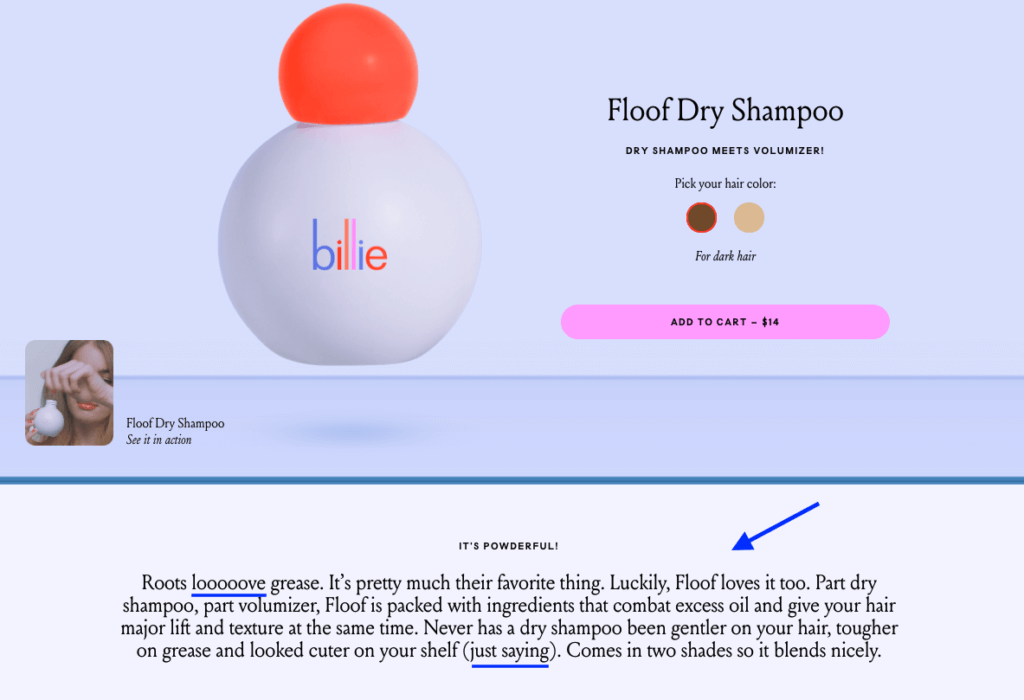
Finally, check for duplicate copy. Use a tool like copyscape.com to make sure you’re not repeating yourself or using copy from another website. Never copy a manufacturer’s product description. Google rewards value-added copy, not cloned copy.
Product Description FAQ
Still have a few lingering product description questions? These FAQ might clear a few things up:
Can I copy a product description from a competitor?
After all, imitation is a form of flattery…right? Well, no matter which way you spin it, the short answer is, no, you can’t lift product descriptions from your competitors.
Even if it were ethical, there’s no guarantee it’d actually help you — or be an effective shortcut. For starters, you’ve no idea how their product description is converting. Meaning, you don’t know if you’re cheating off the valedictorian or the bottom 10% of the class. Plus, even if it is a perfect description for a perfect product, it’s perfect for their brand and customer. Your brand and customer are different — even if you sell similar products — and it’s worth your time to understand how and then cater to those unique differences. (This, by the way, is true for all your product and marketing copy.)
How long should product descriptions be?
Long enough to be helpful, short enough to be digestible.
There’s no hard and fast rule here because the “right” length will vary between product types and how big of a decision the purchase is for the shopper. For example, if I’m buying a $30 accessory trucker hat, I’ll need a lot fewer details and specs than if I’m buying a $500 tent I’ll sleep in every night on the Appalachian Trail.
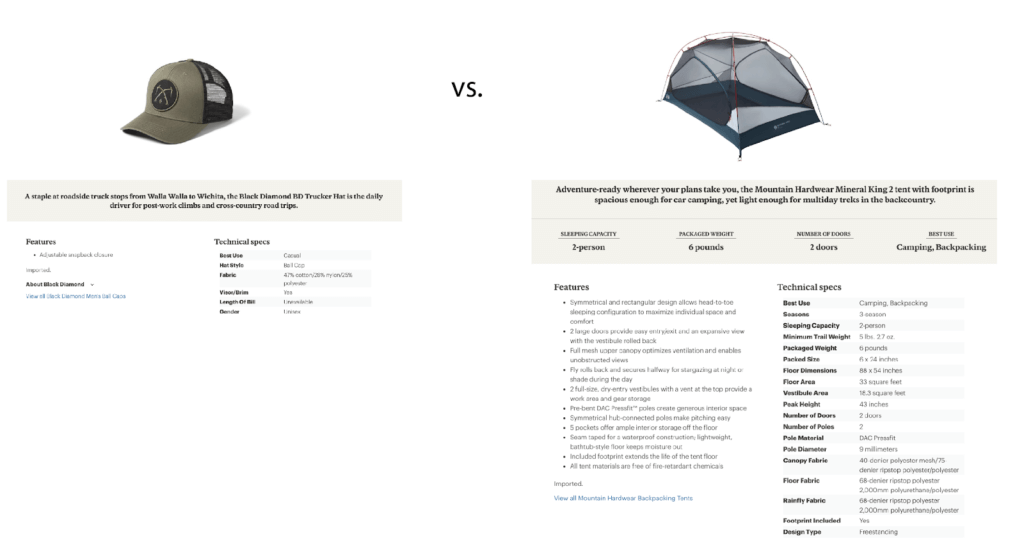
However, most products will fall between these two, so a general guideline for the “right length” is more than a sentence and less than a paragraph for description copy. Plus a handful of easy-to-read bullets that outline key benefits and relevant features.
Overall, remember your main parameter isn’t length — your main parameter is how well the product description serves the customer. If you follow the template and steps we gave up top, you’ll be on track with length.
Are there any power words I can use in my descriptions?
A quick Google search for “copywriting power words” will return list after list of so-called power adjectives. These lists aren’t baseless. Most of them contain words that make us feel. And since buying is an emotional process, words that make us feel can be powerful and persuasive.
However, adding these words to your description doesn’t guarantee your page will convert better. For example, here’s a quick description I pulled together using common power words:
Feel like you just woke up from a panic-filled nightmare, about to plummet off the edge of a meltdown? This life-changing CBD serum is perfect for conquering that ruthless feeling. Our epic mix blends eye-opening aromas with stunning flavors to thwart your seemingly-unbeatable emotions. Now at its lowest price of the season.
That contains no less than a dozen “power words” (according to popular Google search results), but you’re not exactly clamoring for a link to it, are you?
This is because while power words may be correlated with action, sprinkling them in like blueberries in pancakes doesn’t auto-magically cause the visitor to do anything. Plus, some of them are so dang overused (looking at you, innovative) we’re all tired of them.
The best way to add them in is this: write your description using the template and steps above. Make sure it’s crafted for your specific audience, brand, and product above all else. Then, look for opportunities to swap a few weak adjectives or descriptors for something stronger.
One last thought on power words: The most powerful word in your vocabulary isn’t some flowery adjective, it’s a pronoun — you. The biggest power move you can pull in your description is speaking directly to your unique visitor and using the word “you,” the way Moonpod does below.
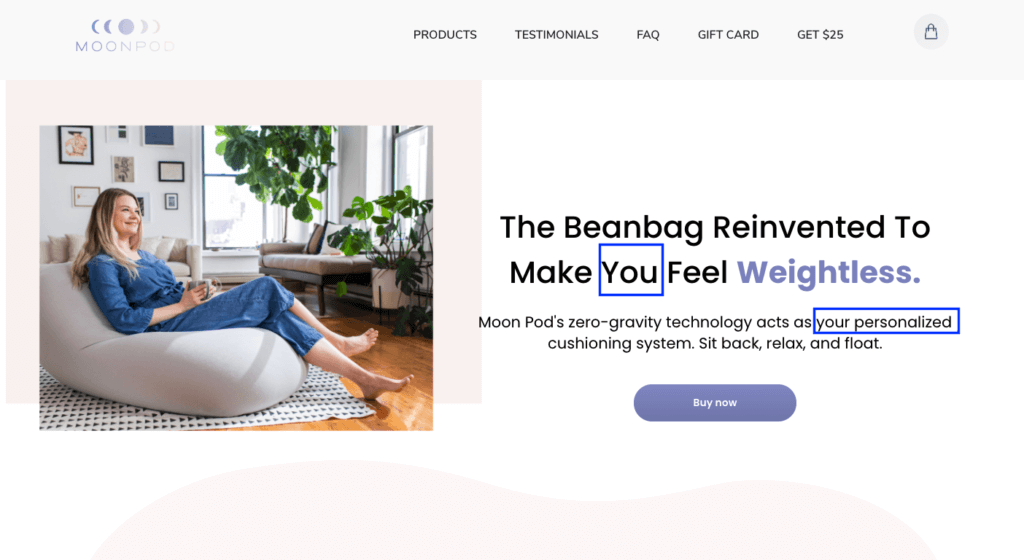
What’s next? Improve your product descriptions today (or get some help from us).
If you have time now, go ahead and evaluate your current product descriptions using the tips and examples we listed above. It takes time, but the potential improvement in sales performance is well worth the investment.
If you don’t have time now and are dashing off to your next meeting, latté, or to-do, you should consider a Digital Experience Optimization Program™. As part of that custom program, we’ll take a close look at your three most important ecommerce pages – the homepage, category page, and product page – and prepare a prioritized list of opportunities for improvement.
If there’s one thing you take away from this article, it should be that optimizing your product descriptions doesn’t have to be difficult. From our experience optimizing hundreds of ecommerce sites, we know that even small, incremental improvements to product page copy can accumulate into significant revenue gains.
Enjoying this article?
Subscribe to our newsletter, Good Question, to get insights like this sent straight to your inbox every week.

About the Author
Laura Bosco
Laura Bosco is a former Content Marketer at The Good and freelance writer. She helps translate thoughts, opinions, and client experiences into written products that are both entertaining and educational.